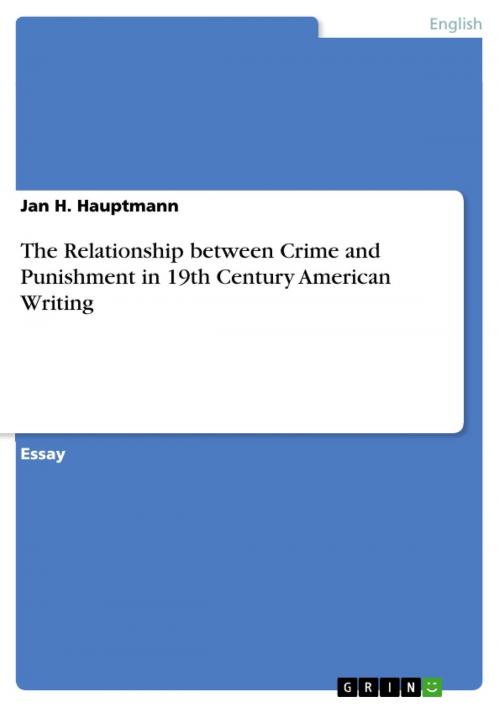The Relationship between Crime and Punishment in 19th Century American Writing
Nonfiction, Entertainment, Drama, Anthologies| Author: | Jan H. Hauptmann | ISBN: | 9783640215089 |
| Publisher: | GRIN Verlag | Publication: | November 19, 2008 |
| Imprint: | GRIN Verlag | Language: | English |
| Author: | Jan H. Hauptmann |
| ISBN: | 9783640215089 |
| Publisher: | GRIN Verlag |
| Publication: | November 19, 2008 |
| Imprint: | GRIN Verlag |
| Language: | English |
Essay from the year 2007 in the subject American Studies - Literature, grade: 1,7, Queen's University Belfast, 9 entries in the bibliography, language: English, abstract: This essay focuses on three American literary works of the 19th century: Nathaniel HAWTHORNE's famous novel The Scarlet Letter was published in 1850, Herman MELVILLE's short story Benito Cereno in 1855, and Mark TWAIN's Pudd'nhead Wilson between 1893 and 1894. While the younger works Benito Cereno and Pudd'nhead Wilson are obviously concerned with the interrelation of blacks and whites, as well as with slavery and its effects on the American society, The Scarlet Letter primarily deals with the Puritan way of life and the law system in New England. Although a direct comparison of the three works seems to be problematical due to their different subject matters, the essay will figure out how crime and punishment is depicted in their broader frame. HAWTHORNE's Scarlet Letter is set in the 17th century in Salem, Massachusetts - the stronghold of New England's Puritanism. The main character of the novel, Hester Prynne, is mother of an illegitimate child (Pearl) and thus a sinner that, according to the strict Puritan laws, has to be ostracised and punished. Her actual punishment is determined by the town's magistracy and consists in the duty to carry a scarlet letter A on her clothes. The adulteress is also presented to an assembly of townspeople on the scaffold of the pillory. Midst of the crowd that is mocking the sinner is Hester's missed husband - Roger Prynne - as well as the person whom she committed adultery with - the Reverend Arthur Dimmesdale. Ironically enough, Dimmesdale is regarded as an extraordinary exemplary Puritan priest by both, the townspeople and the town's magistracy . His guilt remains undiscovered until the end of the novel. Roger Prynne is a stranger at the beginning, who unexpectedly appears at the market-place out of the wilderness . When Hester spots him on the scaffold, he signalises her not to reveal his identity as her husband and starts an indirect inquiry about her, trying to figure out why she is set up to public shame. A townsman congratulates the newcomer to be back in civilisation after being 'a wanderer sorely against [his] own will' and explains what had happened in town and why Hester Prynne is punished on the scaffold.
Essay from the year 2007 in the subject American Studies - Literature, grade: 1,7, Queen's University Belfast, 9 entries in the bibliography, language: English, abstract: This essay focuses on three American literary works of the 19th century: Nathaniel HAWTHORNE's famous novel The Scarlet Letter was published in 1850, Herman MELVILLE's short story Benito Cereno in 1855, and Mark TWAIN's Pudd'nhead Wilson between 1893 and 1894. While the younger works Benito Cereno and Pudd'nhead Wilson are obviously concerned with the interrelation of blacks and whites, as well as with slavery and its effects on the American society, The Scarlet Letter primarily deals with the Puritan way of life and the law system in New England. Although a direct comparison of the three works seems to be problematical due to their different subject matters, the essay will figure out how crime and punishment is depicted in their broader frame. HAWTHORNE's Scarlet Letter is set in the 17th century in Salem, Massachusetts - the stronghold of New England's Puritanism. The main character of the novel, Hester Prynne, is mother of an illegitimate child (Pearl) and thus a sinner that, according to the strict Puritan laws, has to be ostracised and punished. Her actual punishment is determined by the town's magistracy and consists in the duty to carry a scarlet letter A on her clothes. The adulteress is also presented to an assembly of townspeople on the scaffold of the pillory. Midst of the crowd that is mocking the sinner is Hester's missed husband - Roger Prynne - as well as the person whom she committed adultery with - the Reverend Arthur Dimmesdale. Ironically enough, Dimmesdale is regarded as an extraordinary exemplary Puritan priest by both, the townspeople and the town's magistracy . His guilt remains undiscovered until the end of the novel. Roger Prynne is a stranger at the beginning, who unexpectedly appears at the market-place out of the wilderness . When Hester spots him on the scaffold, he signalises her not to reveal his identity as her husband and starts an indirect inquiry about her, trying to figure out why she is set up to public shame. A townsman congratulates the newcomer to be back in civilisation after being 'a wanderer sorely against [his] own will' and explains what had happened in town and why Hester Prynne is punished on the scaffold.















